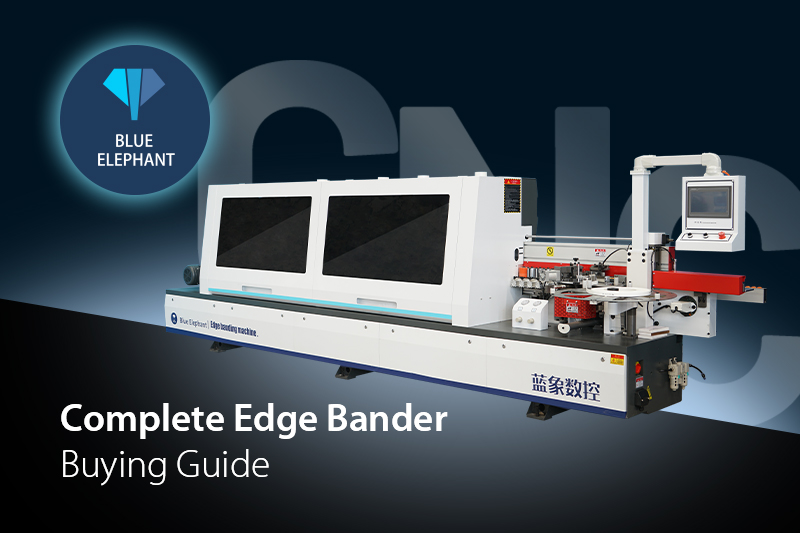In today's woodworking industry, the edge bander stands as a crucial tool. Whether for small-scale workshops or large-scale industrial production, choosing the right edge bander is paramount. However, with a multitude of models and brands flooding the market, finding the perfect edge bander might require some effort. This blog aims to provide you with a comprehensive "Complete Edge Bander Buying Guide," covering fundamental knowledge and key points to guide you in selecting the edge bander that best suits your work needs. Whether it's your first purchase or an upgrade, this guide will assist you in making informed decisions.
What is th edge bander?
An edge bander is a machine used in woodworking to apply a thin strip of material, known as edge banding or edge tape, to the exposed edges of various wood-based panels, such as plywood, particleboard, or MDF (Medium-Density Fiberboard). The purpose of edge banding is to cover and protect the edges of these panels, providing a clean, finished look and enhancing durability.
The machine typically consists of a conveyor system that moves the workpiece through different stages. It applies heat and adhesive to the edge banding material, which is then bonded to the edge of the panel. After application, pressure rollers or other mechanisms ensure proper adhesion and trim the excess edge banding material, resulting in a smooth, seamless edge.
Edge banders come in various configurations, from smaller, portable models suitable for smaller woodworking shops to larger, industrial-grade machines capable of handling high volumes of production. They offer efficiency and precision in applying edge banding to panels, making them a crucial tool in furniture manufacturing and cabinetry work.
How many types of edge bander machines?
Manul edge bander
These are entry-level machines operated manually. They require the operator to feed the panel and guide the edge banding material through the machine.
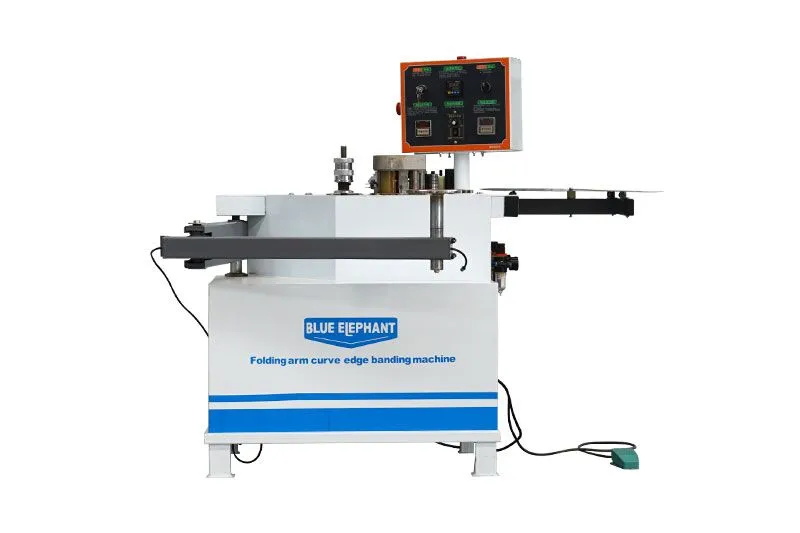
Semi-automatic edge bander
These machines have some automated functions but also require manual intervention for tasks like feeding the panel and trimming excess banding material.
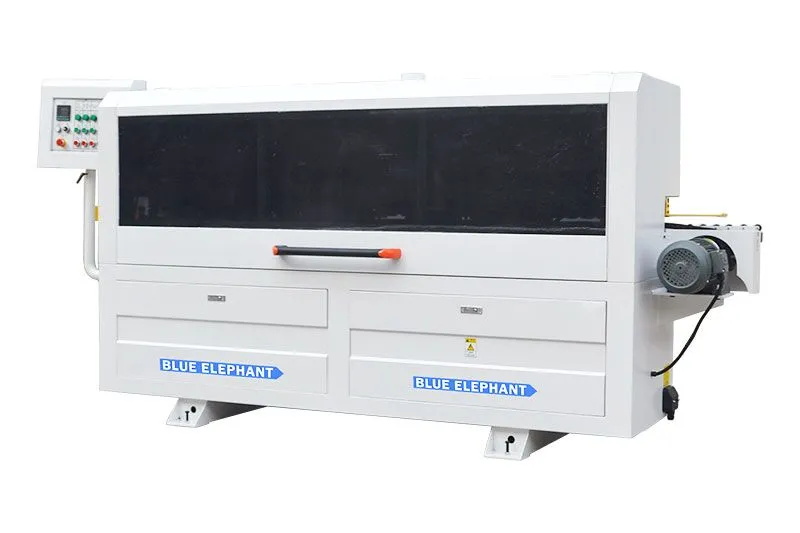
Automatic edge bander
These are highly automated machines that can perform various tasks such as feeding panels, applying adhesive, trimming edges, and buffing, mostly requiring minimal manual intervention.
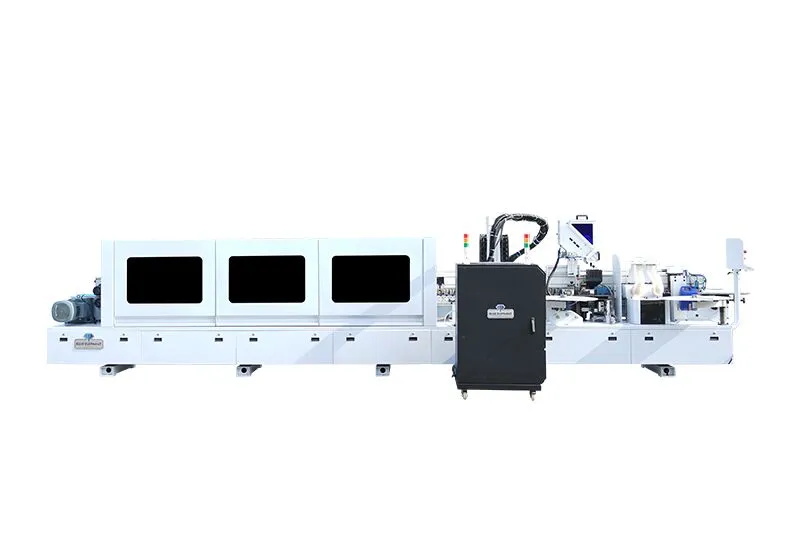
Multifunctional edge bander
Side hole edge bander is a machine specially designed for processing the edge of the board, and it can also drill holes on the side of the board. This type of machine is commonly used in furniture manufacturing and custom furniture production.
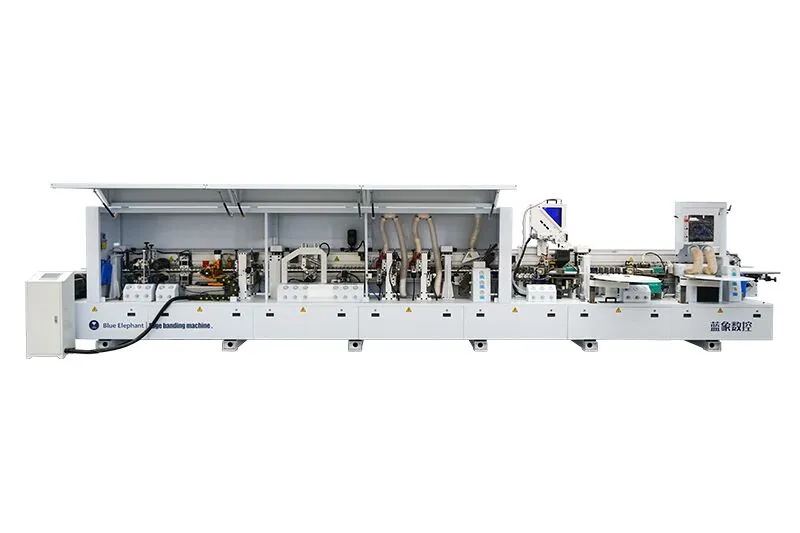
This machine has the functions of edge banding and drilling. It can add edge banding strips to the board while processing it, and drill holes on the side of the board for connection or installation when needed. The side hole edge banding machine is designed to help the edges of the processed panels become flatter and more beautiful, while providing customized drilling options to meet specific needs.
Which edge bander is best for you?
Key Features to Consider:
Edge Thickness and Feed Speed: Ensure the machine can handle your required edge thickness and offers adjustable feed speeds.
Gluing System: Check the gluing mechanism (hot melt, EVA, PUR) for compatibility with your materials.
Trimming Units: Look for machines with various trimming units (end trimming, rough trimming, fine trimming, scraping, buffing) to achieve desired edge finishes.
Control System: Consider the ease of use and programming capabilities of the machine's control system.
Dust Collection: Efficient dust extraction systems are crucial for a clean work environment and machine longevity.
How does the edge bander work?
Feeding the Panel: The process begins by feeding the panel or board through the edge bander. The panel travels along a conveyor belt or rollers to move it through the machine.
Glue Application: The edge bander applies adhesive (usually hot melt glue) onto the edge of the panel. The glue can be applied using various methods, such as a glue pot, roller, or other applicator systems.
Applying the Edge Band: The edge band material, in the form of a roll or strip, is fed into the machine. As the panel moves forward, the edge band is pressed against the edge of the panel, adhering to the applied glue.
Trimming: Once the edge band is applied, excess material needs to be trimmed off to achieve a clean and flush edge. This is done using trimming units equipped with cutters or blades. Common trimming units include end trimmers, flush trimmers, radius trimmers, and scrapers.
Finishing and Buffing: Some edge banders have additional units for finishing touches. These units may perform tasks like edge scraping to remove any remaining material, buffing for a smoother finish, or applying heat to ensure the edge band adheres firmly.
Quality Control: Operators monitor the process to ensure proper adhesion, alignment, and trimming. They may make adjustments to the machine settings as needed to maintain quality.
The entire process is typically automated or semi-automated, depending on the complexity of the machine. Advanced edge banders may have computerized controls that allow for precise adjustments and programming for different edge banding requirements. Here is the video showing how does the edge bander process wood panels.
What are the uses of edge banding machines?
Edge banders for home use
Edge banders are typically industrial machines used in woodworking shops or manufacturing settings to apply edge banding (strips of material) to the edges of furniture or panels. They come in various sizes and capabilities to handle different types of edge banding materials and workloads. However, these machines are not commonly used in home workshops due to their size, cost, and specialized nature.
For home use, there are smaller and more affordable alternatives available that can still provide edge banding capabilities, such as:
Handheld Edge Banders: These are portable tools that allow you to manually apply edge banding to the edges of your woodworking projects. They are smaller, easier to use, and more affordable than industrial edge banders. However, they require more manual work and may not offer the same precision or efficiency.
Edge Banding Tape: An alternative method for home use is applying edge banding tape manually. This involves using pre-glued or heat-activated adhesive tapes that you can trim and apply to the edges of your boards or panels. A household iron or specialized edge banding trimmers can help with this process.
Small Benchtop Edge Banders: Some companies offer compact edge banding machines designed for smaller workshops or home use. These benchtop models are smaller in size compared to industrial edge banders and are more suitable for hobbyists or DIY enthusiasts.
When considering an edge banding solution for home use, it's essential to assess your needs, available space, budget, and the volume of work you plan to undertake. For occasional projects or hobbyist use, manual methods or smaller benchtop models might suffice.
Edge banders for small shop
For a small shop setting where space, budget, and versatility are important factors, there are compact and mid-sized edge banders available that can meet your needs without the bulk or expense of larger industrial machines. These machines are designed to fit into smaller workspaces while still offering efficiency and functionality. Here are a few options to consider:
Compact Edge Banders: Some manufacturers offer compact edge banders specifically designed for small workshops. These machines often have a smaller footprint and can handle various types of edge banding materials. They might have manual or semi-automatic functions and can be suitable for lower to moderate work volumes.
Portable Edge Banders: Portable models are designed to be moved around the workshop easily. They are smaller and can be placed on a workbench or table when needed. While they might have limitations in terms of the width or thickness of the edge banding they can handle, they are practical for smaller shops with occasional edge banding needs.
Mid-sized Edge Banders: These machines fall between compact and industrial-sized edge banders in terms of size and capacity. They are suitable for small to medium-sized shops with a moderate workload. They often offer a good balance between functionality, space requirement, and cost.
Edge banders for large industry
For large industrial settings with high production volumes and demanding requirements, edge banders need to be robust, versatile, and highly automated to ensure efficiency and quality. These machines are designed to handle a wide range of edge banding materials, thicknesses, and sizes while maintaining precision and speed. Here are edge banders for large industry:
Fully Automatic Edge Banders: These machines offer a high level of automation, handling various edge banding processes from start to finish. They often include automatic feeding of panels, application of adhesive, trimming, edge finishing, and corner rounding. Fully automatic edge banders are ideal for high-volume production lines where efficiency and consistency are crucial.
Contour Edge Banders: Designed to handle complex shapes and profiles, contour edge banders are used in industries that require edge banding on non-linear or irregularly shaped panels. They often incorporate CNC technology to precisely apply edge banding to custom or contoured surfaces.
High-Speed Edge Banders: These machines are optimized for speed without compromising quality. They are equipped with advanced cutting, trimming, and finishing units, allowing them to handle a high throughput of panels within a given timeframe.
Multi-Function Edge Banders: Offering a range of functions in a single machine, multi-function edge banders can perform multiple edge processing tasks such as pre-milling, corner rounding, grooving, and various finishing operations. They provide versatility for different edge banding requirements within an industrial setting.
Panel Line Integration: In some large-scale industrial setups, edge banders are integrated into complete panel processing lines, working in conjunction with other machinery like CNC routers, saws, and drilling machines. This integration ensures a seamless workflow and enhances overall productivity.
How to choose a great edge bander?
Edge bander type
Decide between entry-level, mid-range, or high-end models based on your production volume and budget. Entry-level machines may suit smaller operations, while high-end ones offer advanced features for larger-scale production.
Band thickness and material compatibility
Ensure the edge bander accommodates the thickness and material type you commonly work with, whether it's PVC, wood veneer, ABS, or other materials.
Feed speed and glue system
Look for variable feed speeds that suit different materials and optimize efficiency. The glue system should provide consistent and reliable adhesion.
Trimming units
Consider machines with multiple trimming units for precise finishing, including pre-milling, end trimming, flush trimming, radius trimming, and scraping.
Automation and controls
Advanced control systems with touchscreen interfaces or programmable features can enhance efficiency and ease of use.
Maintenance and service
Ensure easy access for maintenance and that the manufacturer provides good after-sales support and spare parts availability.
Space and power requirements
Evaluate the available space in your workshop and check if the machine's power requirements align with your setup.
Reviews and recommendations
Read reviews from other users or consult industry experts for recommendations on reliable brands and models.
Testing and rrials
If possible, conduct trials or demonstrations to assess the machine's performance, accuracy, and reliability firsthand.
Cost consideration
Factor in the initial cost, but also consider the long-term operational costs, including maintenance, energy consumption, and potential downtime.
Who is the best edge bander manufacturer?
Determining the "best" edge bander manufacturer can depend on various factors including the specific needs of your woodworking operation, the features you require, and the level of customer support desired. However, several manufacturers are well-regarded in the industry for producing high-quality edge banders.
-
Blue Elephant: Known for its reliable quality and technologically advanced woodworking machinery, including woodworking engraving machines, CNC drilling machines, edge banding machines, wood cutting machines, polishing machines and so on. And Blue Elephant produces a full range of edge banding machines, including manual edge banding machines, semi-automatic edge banding machines, fully automatic edge banding machines and multi-functional edge banding machines, which can meet the different production and processing needs of the woodworking industry.
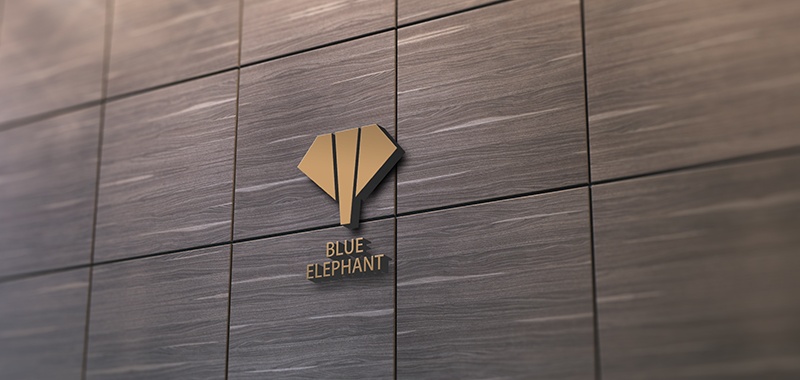
-
Biesse: Known for innovative and technologically advanced woodworking machinery, Biesse offers a range of edge banders catering to different production levels and requirements.
-
Homag: Homag is a reputable manufacturer offering a wide variety of woodworking machinery, including edge banders. They provide solutions for various production scales and customization options.
-
SCM Group: SCM Group produces a range of edge banders suitable for different woodworking needs, from small workshops to large industrial operations, known for their quality and reliability.
-
Brandt: Brandt specializes in edge banders designed for both small and large-scale woodworking operations, offering precision and efficiency in their machines.
-
Holz-Her: Holz-Her is recognized for producing high-performance edge banders with advanced technology, catering to diverse needs in the woodworking industry.
-
IMA Schelling: IMA Schelling offers edge banders known for their precision and customization options, suitable for various production demands.
How much does a edge bander cost?
The cost of an edge bander can vary significantly based on various factors such as brand, model, features, capabilities, and whether it's new or used. Here's a general breakdown:
Entry-Level Edge Bander Price
These can start from around $5,000 to $15,000. They usually offer basic functionalities suitable for smaller workshops or low-volume production.
Mid-Range Edge Bander Price
These fall within the range of $15,000 to $40,000. They provide more features, higher accuracy, and increased automation, making them suitable for medium-sized operations.
High-End or Industrial Edge Bander Price
These can range from $40,000 to $150,000 or more. They are equipped with advanced technology, multiple units for trimming and finishing, high-speed capabilities, and are suitable for high-volume or industrial-scale production.
Used or Second-hand Edge Bander Price
The price of a second-hand edge banding machine is much cheaper than that of a new edge bander. The edge bander proce is generally determined based on wear. Therefore the edge banding machine price may be -40% off the new model.
Tips to maintain the edge bander machines
Maintaining an edge bander is crucial to ensure its longevity and optimal performance. Here are some tips for maintaining edge bander machines:
Regular Cleaning: Clean the machine daily or after every use. Remove dust, wood chips, and residue from the cutting units, conveyor belts, and glue application areas. Use compressed air or brushes to clean hard-to-reach areas.
Lubrication: Follow manufacturer recommendations for lubricating moving parts. Regularly oil chains, gears, and sliding parts to prevent friction and ensure smooth operation.
Check and Replace Consumables: Inspect and replace worn-out or damaged parts regularly, including cutter blades, glue pots, pressure rollers, and conveyor belts. This helps maintain precision and prevents damage to the workpiece.
Calibration and Adjustment: Periodically check and calibrate the machine for accuracy. Ensure the cutting units are aligned correctly, the pressure settings are appropriate, and the trimming units are properly adjusted for the desired finish.
Monitor Glue Application: Check the glue application system regularly. Clean and unclog nozzles or glue spreaders to maintain consistent adhesive application.
Electrical Components and Safety Checks: Inspect electrical connections, switches, and safety features regularly. Ensure emergency stop buttons and safety guards are functioning properly.
Software and Controls: Keep software and control systems updated to the latest versions provided by the manufacturer. This ensures optimal performance and may include improvements or bug fixes.
Training and User Awareness: Provide training to operators on proper machine operation, maintenance procedures, and safety protocols. Encourage reporting of any unusual sounds, vibrations, or issues to address them promptly.
Scheduled Maintenance: Follow the manufacturer's recommended maintenance schedule. This might include periodic professional servicing or inspections to ensure the machine operates efficiently.
Environment Control: Maintain suitable workshop conditions, including temperature and humidity levels, to prevent damage to the machine's components.
Words at Last
Understanding your work requirements is paramount when purchasing an edge bander. Whether aiming for high throughput, precision, or seeking flexibility to accommodate various materials and processes, each work scenario has unique demands. Choosing an edge bander involves more than brand recognition or functionality—it's about how the machine integrates into your workflow to enhance efficiency and productivity. Moreover, understanding post-purchase support and maintenance is equally crucial, as the machine's long-term operation and upkeep directly impact your production efficiency and costs. In conclusion, delving into your needs, researching available options in the market, and ensuring your choice aligns with your expectations and long-term goals will help you find the edge bander that best suits you, providing a stable and high-quality solution for your woodworking production.





